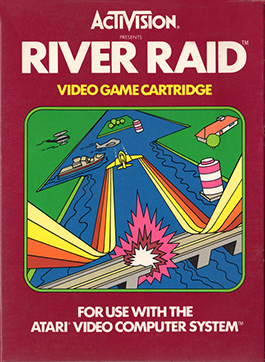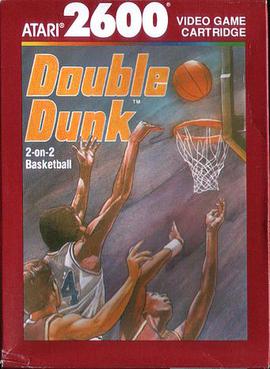
Asteroids is a space-themed multidirectional shooter arcade video game designed by Lyle Rains and Ed Logg released in November 1979 by Atari, Inc. The player controls a single spaceship in an asteroid field which is periodically traversed by flying saucers. The object of the game is to shoot and destroy the asteroids and saucers, while not colliding with either, or being hit by the saucers' counter-fire. The game becomes harder as the number of asteroids increases.

The Atari 2600 is a home video game console developed and produced by Atari, Inc. Released in September 1977, it popularized microprocessor-based hardware and games stored on swappable ROM cartridges, a format first used with the Fairchild Channel F in 1976. Branded as the Atari Video Computer System from its release until November 1982, the VCS was bundled with two joystick controllers, a conjoined pair of paddle controllers, and a game cartridge—initially Combat and later Pac-Man.

Kaboom! is an action video game published in 1981 by Activision for the Atari VCS. It was programmed by Larry Kaplan, and David Crane coded the overlaid sprites. The game was well received and sold over one million cartridges by 1983.

Adventure is a video game developed by Warren Robinett for the Atari Video Computer System and released in 1980 by Atari, Inc. The player controls a square avatar whose quest is to explore an open-ended environment to find a magical chalice and return it to the golden castle. The game world is populated by roaming enemies: three dragons that can eat the avatar and a bat that randomly steals and hides items around the game world. Adventure introduced new elements to console games, including enemies that continue to move when offscreen.

Breakout is an arcade video game developed and published by Atari, Inc. and released on May 13, 1976. It was designed by Steve Wozniak, based on conceptualization from Nolan Bushnell and Steve Bristow, who were influenced by the seminal 1972 Atari arcade game Pong. In Breakout, a layer of bricks lines the top third of the screen and the goal is to destroy them all by repeatedly bouncing a ball off a paddle into them. The arcade game was released in Japan by Namco. Breakout was a worldwide commercial success, among the top five highest-grossing arcade video games of 1976 in both the United States and Japan and then among the top three highest-grossing arcade video games of 1977 in the US and Japan. The 1978 Atari VCS port uses color graphics instead of a monochrome screen with colored overlay.

Ms. Pac-Man is a 1982 maze arcade video game developed by General Computer Corporation and published by Midway. It is the first sequel to Pac-Man (1980) and the first entry in the series to not be made by Namco. Controlling the title character, Pac-Man's wife, the player is tasked with eating all of the pellets in an enclosed maze while avoiding four colored ghosts. Eating the larger "power pellets" lets the player eat the ghosts, who turn blue and flee.

Spelunker is a 1983 platform video game developed by Timothy G. Martin of MicroGraphic Image. It is set in a colossal cave, with the player starting at the cave's entrance at the top, and the objective is to get to the treasure at the bottom.

River Raid is a vertically scrolling shooter designed and programmed by Carol Shaw and published by Activision in 1982 for the Atari 2600 video game console. Over a million game cartridges were sold. Activision later ported the title to the Atari 5200, ColecoVision, and Intellivision consoles, as well as to the Commodore 64, IBM PCjr, MSX, ZX Spectrum, and Atari 8-bit family. Shaw did the Atari 8-bit and Atari 5200 ports herself.

Pitfall II: Lost Caverns is a platform game originally released for the Atari 2600 by Activision in 1984. It is the sequel to Pitfall! (1982). Both games were designed and programmed by David Crane and star jungle explorer Pitfall Harry. Pitfall II adds a much larger world with vertical scrolling, swimmable rivers with deadly eels, music, and balloons for floating between locations.

Skeet Shoot is a skeet shooting video game for the Atari 2600 and the first game released by Games by Apollo in December 1981. Players assume the role of a skeet shooter shooting clay pigeons. There is a two-player mode where the players alternate.
Games by Apollo Inc. was a third-party developer of games for the Atari 2600 video game system, based in Richardson, Texas. It was founded in October 1981 by Pat Roper as a subsidiary of his National Career Consultants (NCC). Apollo's first title was Skeet Shoot, and neither it nor the ten games that followed caught on, and the company was one of the first to declare bankruptcy as a result of the video game crash of 1983.

Superman is a video game programmed by John Dunn for the Atari Video Computer System and released in 1979 by Atari, Inc. The player controls Superman, whose quest is to explore an open-ended environment to find three pieces of a bridge that was destroyed by Lex Luthor, capture Luthor and his criminal gang, and return to the Daily Planet building. The game world is populated by antagonists such as a helicopter that re-arranges the bridge pieces and roving kryptonite satellites that cause Superman to revert into Clark Kent.
Todd Rogers is an American video game player who has been described as the first professional video game player. In 1986, he was invited to be part of the U.S. National Video Game Team. He had personally claimed without any evidence to be recognized by Activision for having achieved many record-setting high scores, but many of his records were later disputed for a lack of verifying evidence or found to be impossible to achieve. In January 2018, the Twin Galaxies record database removed all of his scores from their leaderboards and banned him permanently, and Guinness World Records stripped his records.

Space Cavern is a 1982 fixed shooter video game for the Atari 2600 developed and released by Games by Apollo. Players control a spaceship commander who has landed on a planet and must defend the ship against its hostile creatures. Games by Apollo founder Pat Roper was impressed by the game Demon Attack and tasked Apollo member Dan Oliver with making a game very similar to it.

Spacechase is a fixed shooter video game for the Atari Video Computer System written by Ed Salvo and published by Games by Apollo in 1981.

Double Dunk is a basketball video game developed by Atari Corporation and released in 1989 for the Atari 2600. Programmed by Matthew Hubbard, who previously wrote Dolphin and Zenji for Activision, Double Dunk was one of the last games produced by Atari for its well-known console.

Solar Fox is an arcade game released in 1981 by Bally/Midway. It was ported to the Atari 2600 console and was also released as a Commodore-published cartridge for the Commodore 64 computer in 1983.

Lost Luggage is a 1982 action video game developed and published by Games by Apollo for the Atari 2600. The player controls skycaps working at an airport and tries to collect pieces of luggage that fall overhead from a frantic luggage carousel. A two-player mode, in which the second player controls the direction the luggage falls, is also available.

Miniature Golf is a golf video game developed for the Atari VCS by Tom Reuterdahl and published by Atari, Inc. in 1978.

Video Checkers is a 1980 video game developed and published by Atari, Inc. for the Atari VCS.



















